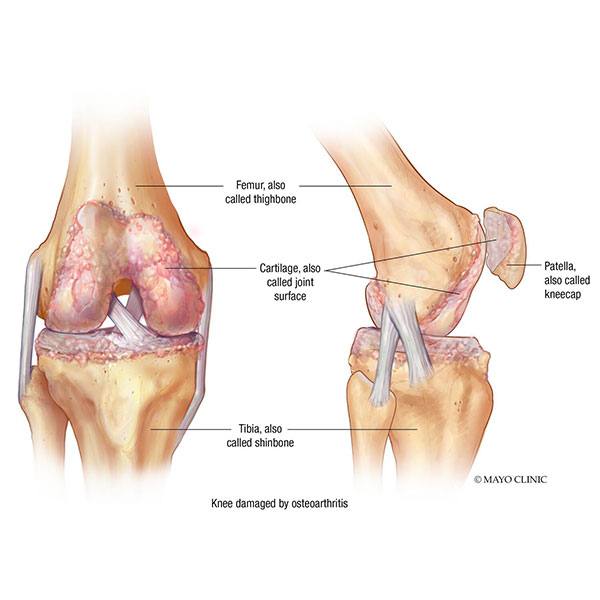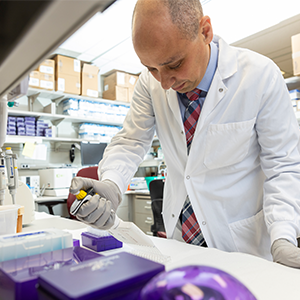-
Research, Cures and Future Medicine
Chronic diseases are on the rise. Many have no easy treatment, some none at all.
"As a medical institution, we won't accept that the current state of affairs is as good as it gets," says Gianrico Farrugia, M.D., Mayo Clinic's president and CEO.
Facing a decade of intense change in medicine along with unprecedented opportunities, Dr. Farrugia has developed a plan to respond, engaging new tools and a mindset to accelerate discovery in order to cure disease.
"Increasingly, 'cure' is a reality we will be able to provide," says Dr. Farrugia.
Dr. Farrugia — the first Mayo Clinic president and CEO who comes to the role with a background as both a clinician and a laboratory scientist is no stranger to thinking about how research progresses. From his own research experience, Dr. Farrugia relates that it's important to focus and hone your expertise, but still keep an open mind. When unexpected results pop up, he says, "Track them down, and then become rigorous about the unexpected."
Having a plan and still embracing the ability to formulate a new approach is key to success in research. It's been an effective approach in his own career.

Embodying the Practice and Research shields
Dr. Farrugia came to Mayo Clinic 31 years ago during his training as a gastroenterologist, following medical school in his native Malta. While his clinical practice developed, he was inspired by mentors to develop his own research lab, which he continues to lead. Over the years, his team has investigated the ability of the gastrointestinal tract to break down food and move particles through digestion, providing insight into diseases like diabetes. In 2011, when the recently sequenced genome began to appear a potential tool for diagnosing and treating disease, Dr. Farrugia pivoted to become the first director of Mayo Clinic's Center for Individualized Medicine to help move genomic discoveries to patient care. Another pivot and a new plan took shape during the four years he spent as CEO of Mayo Clinic in Florida before taking the helm of Mayo Clinic as a whole.
That same combination of intention and open-ended thinking underlies the research plan for the institution. As we move through the next decade, Mayo will accelerate the pace of discovery, moving it toward cures.
"We're building on the research structure we have in place as a successful pipeline for fundamental discoveries, which we can apply clinically for patients," says Gregory Gores, M.D., executive dean for Research, Mayo Clinic. But the emerging strategy also will take advantage of the unexpected, enabling researchers to tackle questions with imaginative, new approaches that disrupt the status quo.

"We want to change the way we think," says Dr. Gores. "We're interested in big ideas. We want to make big bets and to invest in ideas that will make a difference in the world."
What does that look like in action? Mayo will continue to focus on developing cures for diseases with an eye on the "new new." Dr. Gores and other research leaders across Mayo Clinic see several emerging and reemerging areas on the horizon.
A Good Idea in Good Time: Gene Therapy
One area that may see a revival is gene therapy, which stalled throughout the world in the past as scientists had few methods to introduce new genes safely. But recently developed experimental approaches are now on promising trajectories, notes Dr. Gores. Studies in the past relied solely on using viruses to introduce fragments of corrected genes as therapy. Newer approaches are using safer vectors — the gene delivery mechanisms — in addition to nonvirus strategies. Further, new gene editing techniques, like CRISPR-Cas9, may make it possible to modify genes with transient approaches that have a short-term clinical effect or that can be targeted to isolated areas, such as the eye. Future methods also may affect multiple genes at once, which may have more impact and reduce negative side effects for patients.
Research Hitting Its Stride
The field of individualized medicine, which identifies genomic causes of disease, has increasing applications, including identifying through genes whether or not a person will respond to specific drugs.
The field of regenerative medicine will troubleshoot some of the confounding issues that arise in stem cell treatments. One team of Mayo Clinic researchers recently developed a biodegradable gel as a substrate to grow stem cells in a flat sheet. Because the gel can be placed along a surface, such as the back of the eye, stem cells can be used to restore retinal tissue. This information may turn out to be useful in treating macular degeneration.
Another field ― cancer immunology ― also has seen recent changes that are affecting care. Mayo Clinic researchers made foundational discoveries leading to understanding of PDL1, a protein on the surface of cancer cells that interacts with the body's disease-fighting T cells. That led to a new class of immunotherapy drugs, which use the body's own immune system to fight cancer. And additional PDL1 studies are continuing to further this type of treatment.

From Lab Bench to Patient Bedside
All of these advances will require Mayo's continuing investment in discovery science, the experiments that reveal how things work, and which cellular or molecular interactions can be targeted to prevent or improve a medical issue. Built into Mayo's new research strategy is the intention to accelerate the pace of research and move those discoveries quickly into therapies. These steps will rely heavily on Mayo's well-established approach of team science, which brings together specialists from different disciplines and harmonizes their varied expertise.
"We help assemble the workforce," says Dr. Gores. "We get people to pivot and address a new challenge, and bring their skills together to think creatively and inspire new approaches." Mayo aids these investigators' ability to work together and with experts in wide-ranging areas beyond the lab.
Connecting With Patients Everywhere
The coming era also will increasingly integrate digital technology into science and medicine. Mayo already is establishing strong research capabilities in the use of artificial intelligence (AI) and machine learning. Researchers are drawing on decades of clinical data from patients who have agreed to provide details from their health records to develop AI algorithms as the basis of new diagnostic tools.
One Mayo Clinic research team, for example, recently developed a stethoscope that digitally records a patient's heart sounds and produces an EKG of the heart's electrical activity. An AI algorithm not only reads subtle patterns in the captured data to determine whether there's a problem, but also it can predict whether that patient is at risk for future heart disease.

Tools like stethoscopes that can harness and interpret complex information ultimately will enable patients to connect remotely for a diagnosis. In addition to diagnostic tools, Mayo also will build digital platforms — coordinated programs for accessibility — to bridge those distances. One digital platform, already in the works, evolved from the Mayo Clinic-led discovery of a gene and drug development for polycystic kidney disease. AI-based radiologic screening tools, also developed at Mayo Clinic, use images to measure the volume of the kidney ― a detail that can reveal whether the disease is progressing. While ongoing research is speeding genetic analysis and developing individualized drugs for people with polycystic kidney disease, the available diagnostic components can help patients understand their disease and their prognosis. In the not-too-distant future, patients worldwide may use the polycystic kidney disease digital platform wherever they are to assess their disease and determine whether they need specialized treatment.
"We've never thought this way before," says Dr. Gores. "The model of health care has been, come to Mayo and once you're here, we'll do the right tests and tell you what you need to know. We've never thought about building informative platforms of your ultrasounds, your blood tests, your X-rays, and your genes, so that you stay where you are, and we'll provide you with the information you need."
He adds that digital engagement may enable people to participate more easily in clinical trials. Researchers have found that one of the top reasons people hesitate to enroll in clinical trials is because they perceive trials as time-consuming and costly. However, if people can log in and enter the relevant information, or wear a device that wirelessly transmits the data associated with the study, they may find it easier to contribute to the clinical stages of research. Such a step not only will speed research, but also may make studies more diverse, attracting wider populations.

As research grows increasingly complex, Mayo Clinic will engage partners with specialized skills or technologies. In some labs, that's already commonplace. Some cardiology research teams, for example, have embedded engineers in clinical areas, even observing during procedures. The collaborations help identify new areas of opportunity and the potential capabilities of new tools.
"Our researchers have always been good about creating partnerships across the enterprise and with researchers across the world. As an institution, we'll be intentional about the large-scale partnerships we create," says Dr. Farrugia.
Dr. Farrugia points out that being at the cutting edge of research will mean confronting emerging issues at the intersection of society and science in topics like data privacy or genetic engineering. Mayo Clinic research, he says, is always guided first and foremost by its main value: serving the needs of patients.
"We won't pursue anything for any reason unless the goal is to advance patient care," says Dr. Farrugia. To help navigate emerging issues, Mayo Clinic will work closely with its team of bioethicists and with its community advisory boards. It will have bold conversations with collaborating partners about their standards, as well.
All of these efforts will provide results that are rigorous, well-tested and ultimately effective, and that's the point, says Dr. Farrugia.
"Our goal is to be deliberate, to keep the opportunity open for happenstance, and to accelerate with intention. Instead of saying, 'Well, it will happen when it will happen,' we're saying, 'There are people worldwide who will need the results of our research tomorrow.' And we've got to push for that. We owe it to our patients."
― Kate Ledger, March 2020







